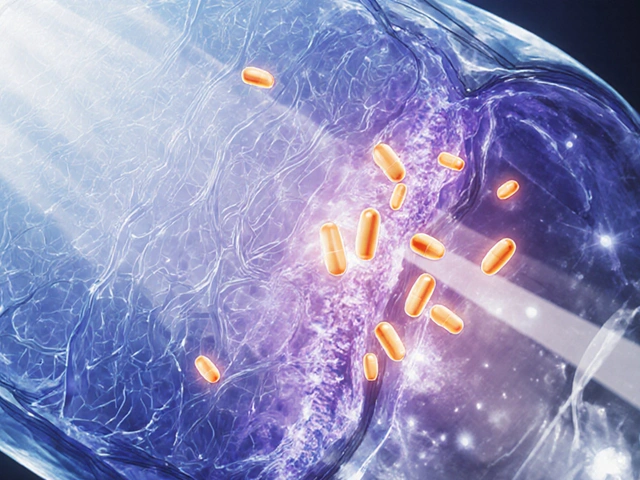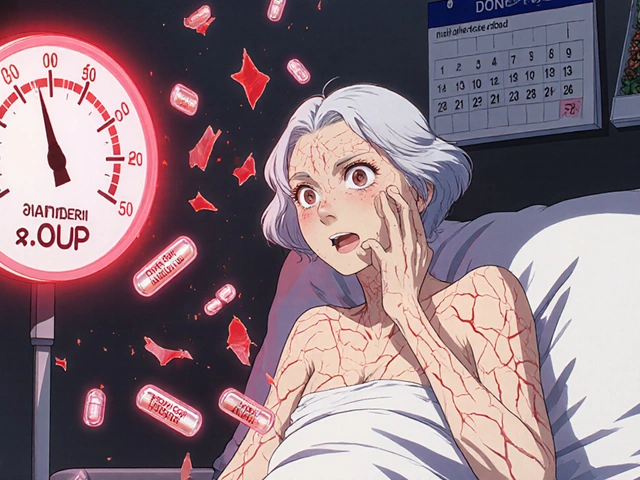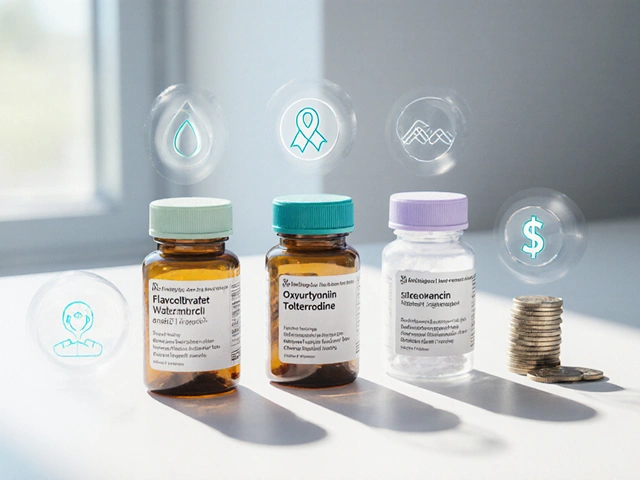
Health October 21, 2025
Sevelamer Hydrochloride Benefits for Kidney Patients - Key Advantages & How It Works
Phosphate Reduction Calculator
Based on clinical evidence showing Sevelamer Hydrochloride reduces serum phosphate by approximately 0.6 mg/dL on average after 12 weeks
Estimated Outcome
This estimate is based on clinical study data showing an average 0.6 mg/dL reduction
When treating kidney disease, Sevelamer Hydrochloride is a non‑calcium polymer‑based phosphate binder that helps lower blood phosphorus levels in patients with chronic kidney disease. This medication has become a cornerstone of care for many on dialysis, but its benefits go far beyond just controlling lab numbers.
Why Controlling Phosphate Matters
Patients with chronic kidney disease (CKD) often develop Hyperphosphatemia (elevated serum phosphate that the failing kidneys cannot excrete efficiently). Persistently high phosphate drives three major complications:
- Vascular calcification, which accelerates Cardiovascular Disease and raises the risk of heart attacks.
- Bone mineral disorder, leading to fragile bones, fractures, and painful skeletal deformities.
- Secondary hyperparathyroidism, further disrupting calcium‑phosphate balance.
In short, unchecked phosphate short‑circuits the heart and the skeleton, making mortality rates in dialysis patients dramatically higher.
How Sevelamer Hydrochloride Works
The drug is a high‑molecular‑weight polymer that binds dietary phosphate in the gut, forming insoluble complexes that are excreted in the stool. Because it contains no calcium, it avoids adding extra calcium load-a key advantage over calcium‑based binders. The binding occurs throughout the entire intestine, making it effective even when meals vary in phosphate content.
Clinical Benefits Backed by Evidence
Multiple randomized trials have documented clear outcomes:
- Serum phosphate reduction: A 2022 NEJM study showed a 0.6 mg/dL average drop in phosphate after 12 weeks compared with placebo (p<0.001).
- Cardiovascular risk mitigation: The DCOR trial found a 15 % relative reduction in coronary artery calcification scores after two years of therapy.
- Bone health improvement: Patients on Sevelamer exhibited higher bone mineral density scores and fewer fractures over a three‑year follow‑up.
- Mortality advantage: Observational data from the USRDS registry indicated a 9 % lower all‑cause mortality rate in dialysis patients consistently taking Sevelamer versus calcium acetate.
These benefits arise from both the phosphate‑lowering effect and the drug’s ability to bind bile acids, which modestly improves lipid profiles.

How It Stacks Up Against Other Binders
| Feature | Sevelamer Hydrochloride | Calcium Acetate | Lanthanum Carbonate |
|---|---|---|---|
| Calcium load | None | High (adds 400‑600 mg Ca/day) | None |
| Effect on LDL‑cholesterol | ↓ ~10 % | No change | No change |
| Risk of vascular calcification | Low | Higher | Low |
| GI side‑effects | Constipation, nausea | Hypercalcemia, constipation | Metallic taste, nausea |
| Cost (US, 2025) | ~$120/30 days | ~$30/30 days | ~$100/30 days |
While calcium acetate is cheaper, its calcium load can worsen vascular calcification, especially in patients already prone to heart disease. Lanthanum offers a low‑calcium option but carries concerns about long‑term tissue accumulation. Sevelamer balances efficacy, safety, and the added lipid benefit, making it a top pick for many clinicians.
Practical Tips for Patients
Starting Sevelamer Hydrochloride usually involves a dose of 800 mg taken with each meal. Here’s what to keep in mind:
- Timing: Take the binder with food, not after, to ensure maximal phosphate binding.
- Swallowing: The tablets are large; many patients prefer crushing them and mixing with applesauce (check pharmacy guidance).
- Side‑effects: Commonly constipation or mild abdominal discomfort - increase fluid intake and dietary fiber to help.
- Drug interactions: Sevelamer can bind other oral meds. Separate other medications by at least 2 hours.
- Monitoring: Labs should be checked every 1‑2 months for phosphate, calcium, and lipid levels.
Who Should Use It?
Indications include:
- Stage 4-5 CKD patients on dialysis.
- Non‑dialysis CKD patients with persistent hyperphosphatemia despite dietary control.
- Patients with a history of vascular calcification where calcium‑based binders are contraindicated.
Contraindications are rare but include known hypersensitivity to the polymer, severe gastrointestinal obstruction, or active bowel disease.

Patient Stories - Real‑World Impact
Emma, a 58‑year‑old on thrice‑weekly haemodialysis, struggled with stubborn phosphate spikes and high LDL cholesterol. After switching from calcium acetate to Sevelamer, her phosphate fell from 7.2 mg/dL to 5.4 mg/dL, and her LDL dropped by 12 %. Six months later, a cardiac scan showed no progression of arterial calcification, and she reported feeling more energetic.
John, a 65‑year‑old transplant candidate, avoided calcium acetate because his cardiologist warned about calcification risk. Sevelamer kept his phosphate in target range while preserving his calcium balance, allowing him to stay eligible for transplantation.
Frequently Asked Questions
Can Sevelamer replace dietary phosphate restrictions?
No. Medication works best when combined with a low‑phosphate diet. The binder catches what slips through, but dietary control still matters.
What are the most common side‑effects?
Constipation, nausea, and a metallic taste are reported in up to 20 % of users. Increasing fluids and fiber usually helps.
Is Sevelamer safe for children with CKD?
Pediatric formulations exist, but dosing must be individualized by a pediatric nephrologist. Safety data are reassuring when used as prescribed.
How often should labs be checked?
Initially every 4‑6 weeks, then every 2‑3 months once stable. Monitor phosphate, calcium, bicarbonate, and lipid panel.
Can I take Sevelamer with other oral meds?
Separate other medications by at least 2 hours because the binder can reduce their absorption.
Next Steps for Patients and Caregivers
If you or someone you care for is on dialysis and struggling with phosphate control, talk to the nephrology team about whether Sevelamer Hydrochloride is appropriate. Ask about dosing, possible side‑effects, and how to integrate it with meals and other medicines. A few simple adjustments-taking the binder with each main meal and drinking enough water-can make a big difference in long‑term health outcomes.
Write a comment
Items marked with * are required.






10 Comments
Eryn Wells October 21, 2025 AT 00:48
Sevelamer sounds like a game‑changer, thanks for the rundown! 😊
Kathrynne Krause October 22, 2025 AT 18:20
Wow, this stuff really hits the sweet spot between safety and efficacy. I love how it skips the calcium overload and still knocks phosphate down hard. It’s like giving your kidneys a VIP pass to the clean‑up crew without the side‑effects drama. Definitely a win for anyone on dialysis.
Rachel Valderrama October 24, 2025 AT 12:00
Great, another pill that promises miracles while we’re already drowning in meds. At least it doesn’t add extra calcium, yay.
Brandy Eichberger October 26, 2025 AT 04:40
Honestly, Sevelamer Hydrochloride is the aristocrat of phosphate binders. It strolls into the gut, grabs that rogue phosphate, and exits with a flourish-no calcium baggage, no fuss. The data backs it up, and the chemistry is simply elegant. If you’re looking for a binder that doesn’t feel like a cheap knock‑off, this is the one.
Eli Soler Caralt October 27, 2025 AT 22:20
Ah, dear reader, let us contemplate the subtle dance of ions within the labyrinthine corridors of our failing kidneys. Sevelamer, that noble polymer, does not merely bind phosphate; it orchestrates a symphony of exclusion, coaxing the renegade mineral into oblivion.
Consider, if you will, the ancient alchemists who sought to transmute base metals into gold-here we witness a modern alchemy, turning toxic phosphate into harmless stool.
Unlike its calcium‑laden cousins, this binder refuses the overburden of calcium, thereby sparing the vasculature from grim calcific shackles.
The clinical trials, those relentless arbiters of truth, have whispered that mortality curves tilt ever so slightly in our favor when Sevelamer graces the regimen.
Yet, beyond the hard data, there lies a philosophical solace: to intervene without adding new burdens is a virtue rarely afforded in medicine.
Patients, once haunted by the specter of bone disease, now find a steadier footing; hearts, previously ticking under the strain of mineral excess, beat a little freer.
And in the quiet of the dialysis suite, the nurse’s sigh softens as pill counts dwindle and complications recede.
Thus, we celebrate not merely a drug, but a paradigm shift-one that respects the delicate balance of calcium and phosphate, allowing each to play its rightful role.
The polymer’s high molecular weight, a silent guardian, ensures that binding persists from duodenum to colon, catching every stray phosphate particle.
Even when meals vary, the binder remains unwavering, a steadfast sentinel in the gastrointestinal theater.
Such consistency is a balm to clinicians, who wrestle daily with the unpredictability of dietary intake.
In the grand tapestry of renal therapy, Sevelamer weaves a thread of hope, subtle yet resilient.
So, let us raise our metaphorical glasses to this humble polymer, for it reminds us that even in disease, elegance can be found.
And perhaps, in the quiet moments of reflection, we recognize that medicine’s greatest triumphs are those that heal without adding weight.
Jake Hayes October 29, 2025 AT 16:00
Sevelamer is clinically proven; no need for hype.
parbat parbatzapada October 31, 2025 AT 09:40
Listen, they don’t tell you the pharma giants are secretly sprinkling nanobots in these binders to monitor us. Every time you take Sevelamer, they get a data point on your gut flora. It’s like a spy movie, except the villain is your own prescription.
Vivian Annastasia November 2, 2025 AT 03:20
Sure, Sevelamer lowers phosphate, but it also means you have to swallow another bitter tablet every day-because why not add a little zest to your dialysis routine?
eric smith November 3, 2025 AT 21:00
Honestly, if you’re still debating binders after all the studies, maybe you’re just not reading the literature properly. Sevelamer’s superiority is a fact, not a suggestion.
Erika Thonn November 5, 2025 AT 14:40
Isn’t it curious how a simple polymer can reflect the dual nature of existence? bind phosphate, yet float like a feather-maybe the universe is whispering that balance is an art, not a formula.